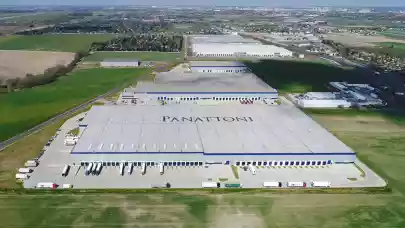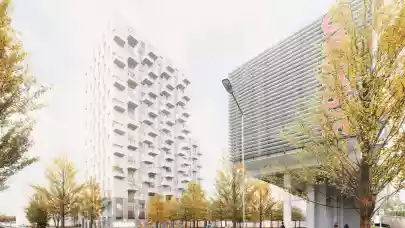
Panattoni increasingly invests in post-industrial land. The share of brownfield sites in the developer's overall portfolio is steadily increasing. In countries such as Germany, France and the Czech Republic, they now even make up more than half of all of its projects under development. Altogether, this type of development now accounts for one-third of the total space completed by Panattoni in Europe and they are a perfect fit with the sustainable development strategy followed by the developer.
Interest in post-industrial land is increasing.
Demand for warehousing in well-connected urban areas has been increasing annually by 15-20%[1], for several years and the reclamation of post-industrial sites will be one of the main trends in the warehouse market over the coming years. The share of this type of development has also been confirmed by a Panattoni study based on the developer's portfolio covering the years 2020-2022. In Germany, Panattoni's brownfield site developments accounted for a large majority of the total, which was as high as 70%. In the Czech Republic, on the other hand, this share increased from 38% in 2020 to 60% in 2022, and in Slovakia from 66% to 80%. In France, the Netherlands, and Belgium, brownfield developments on average accounted for at least half of the investment portfolio over the 2020 to 2022 period. In Poland, the percentage of the company's brownfield site developments came to 33% in 2022.
“Out of 317 of our developments in Poland over the last three years, as many as 77 have been brownfield projects. They are increasing in number, as the supply of construction land is dwindling and competition for investment sites is intensifying. At the same time, post-industrial sites are extremely attractive to investors, despite their higher development costs. They are most often located within city limits, which means they have better communication and access to infrastructure. They are readily taken up by e-commerce and logistics companies as part of the so-called last mile," explains Michał Samborski, the Head of Development at Panattoni.
Construction of Panattoni's park in the Grand Paris Sud industrial zone will start this summer. This is one of the most important industrial areas in France with limited access to new land. The park will be built on a site previously occupied by a concrete factory and a warehouse for construction materials. The developer has planned to transform the site into a modern logistics centre, to serve France's booming e-commerce market. As part of the redevelopment, new buildings are to be constructed with façades made of recycled materials and solar panels will be installed on 60% of the roofing over the industrial space while the roofs of the office buildings are to be covered with vegetation.
Sustainable development through redevelopment
Brownfield investments bring back to life assets and spaces that have lain idle for years, and their reuse contributes to the conservation of the environment. “Land reclamation and redevelopment of brownfield sites is one facet of responsible land management for European Union Member States and part of its sustainable development policy. We restore degraded land to its original purpose, while at the same time carrying out a range of activities to conserve the environment and local ecosystems. In this way, we contribute to reducing CO2 emissions, creating jobs and improving the quality of life of local communities,” says Piotr Kociołek, the Environmental Director at Panattoni.
Among other things, the remediation of brownfield sites includes removing soil contaminants, stabilising the soil and introducing new plant species. As a result, such sites become safe for people and environmentally friendly again, while their aesthetic value and their utility is also increased. In 2020, soil remediation work began at Panattoni Park Slough in the UK. ICI Paints, which had previously used the site, left behind soil heavily contaminated with solvents, hydrocarbons and paint waste. Another example in Germany is Panattoni Campus Hanover City Centre, which is being built on a 130-year-old industrial site contaminated with materials from World War II. The redevelopment work has been underway for a year, and most of the demolition material is to be used in the building's foundation. The land on which Citi Logistics Katowice (Poland) was built was also remediated. Located on ul. Miedziana, the parcel of land is in a historical mining and smelting area and the ground there had been partially contaminated with petrocarbons and heavy metals. Through remediation, the developer reclaimed around 2,000 cubic metres of soil at a cost of €330,000.
Work on such developments also reduces the consumption of energy, water and other resources. This is because centres built on post-industrial sites fit in with the principles of the closed economy and are more energy efficient and this means that the harm they do to the environment is reduced. As with all other Panattoni centres, they are environmentally certified, under BREEAM currently for a rating of Excellent. The first to receive such a high assessment was a brownfield investment - Panattoni Park Sosnowiec (Poland) located on the site of a former glasswork. Next, In Mannheim Ost, Ladenburg (Germany), Panattoni built a centre for a logistics operator - neska - which was certified with Gold (DGNB Gold) by the German Sustainable Building Association. A new habitat was created on the site for a local species of lizard, demonstrating a harmonious balance between development and ecological conservation.
Moving towards a closed economy
When brownfield sites are transformed, many building materials are recycled or reused. This reduces the need for fresh raw materials and reduces waste. In the construction of City Logistics Kraków in Poland at a former concrete factory in Nowa Huta, 90% of the waste was recycled. In the case of Panattoni Park Ostrov North in the Czech Republic, which was built on the site of a decommissioned Škoda Ostrov trolleybus factory, up to 98.7% of the demolition materials were recycled and 96.7% of them were reused during the development site. This reduced the transport of construction materials by around 10,300 trucks.
As Emilia Dębowska, the Sustainability Director at Panattoni points out: "Bringing brownfield sites back to life is an important step towards a green future. Brownfield developments reduce resource consumption and CO2 emissions, improve the quality of life for local communities, and conserve the environment. By developing this type of project across Europe, Panattoni is demonstrating its determination to achieve its sustainability goals, both locally and globally. We should expect that the share of brownfield projects out of the total number of developments is only going to continue to grow."



